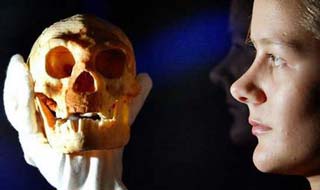 Introduction to Archaeology
and Palaeoanthropology:
Introduction to Archaeology
and Palaeoanthropology:
 Introduction to Archaeology
and Palaeoanthropology:
Introduction to Archaeology
and Palaeoanthropology:
Humanity's Journeys
Dr. Kathryn Denning
Anth 2140, Sept 2005 - Apr 2006
15 Nov 2005... Welcome!
Plan for the day
1 Course business/ announcements...
2 Evolution - early Homo sapiens and other hominids
Schedule
For today/tomorrow: Fagan: Ch 9 African Exodus, KIT: Sex, gender, and the behaviour of early Homo (See revised reading schedule.) Make sure you do this reading -- it will help in tutorial discussions tomorrow.
Remember, you're responsible for doing and knowing the reading. Lectures are not a replacement for the textbooks.
Tomorrow in tutorial: Looking at popular representations of 'cavemen' etc...
Quiz 2 - Overall, the class did extremely well. Congratulations!
A few key principles about hominoid & hominid evolution
challenges include these:
When we’re studying fossils: We have to contend with infrequent fossilization, fragmentary remains and the challenges of taphonomy (the changes that occur to organisms or objects after being buried or deposited), including scattering of remains, exposure to the elements, etc. Have to consider why things are found together (deliberate deposition, accidental coincidence, etc.)
- fragmentary, damaged, infrequent fossils, often without a population for comparison ... so it can be hard sometimes to decide whether a fossil is a new species, or a variant on an older one, or whether it's a male or female. Entire skeletons are quite rare.
- this means there's a lot of room for differences of opinion, and different names for the same fossil... usually when a new type of fossil is found, it takes a few years for consensus about it to emerge
- new finds rewrite the taxonomies, quite often
- dating can be a challenge. Potassium argon dating is the primary method used for dating hominid fossils, but note -- this is dating the volcanic rock layers above or below the fossil, rather than the fossil itself.
[Radioactive potassium decays to argon gas... so we can only use this method on minerals which contain potassium and then trap the argon gas so that we can measure it. Volcanic tuff (compressed ash) has this chemical composition... and there's lots of it in East Africa, which is handy for hominid dating.]
Date range for K-AR - from 250 000 years ago back to the origins of life.
We can also use C14 dating, but that's for later specimens (not fully fossilized), from about 40 000 BP until present.
Note regarding dates/terminology:
mya = million years ago
kya = thousand years ago
BP = before present
BC = Before Christ = BCE = Before Common Era
AD = Anno Domini = CE = Common Era
Also recalling -- how do we picture evolution taking place?
The "March of Progress" iconography... this is not how things happened.

Below, is a better way of representing human evolution.
.. we have many different specimens (these are just a few), and although we can group them approximately with a high degree of confidence, we can't trace a single line of human evolution.

And also recalling... something important about adaptations.
there is variability in any population, and various evolutionary forces then affect the prevalence of different traits. (forces including natural selection, sexual selection, genetic drift, mass extinction events, etc.)
but note! according to standard evolutionary explanations: the variability doesn't arise "for a reason", i.e. there's no big plan or direction for evolution. So, for example, our primate ancestors began to develop nimble hands... but they didn't develop nimble hands so that we could later hold a pencil. They started to develop nimble hands, which proved to be an advantage in a certain environment, and then also turned out to have additional uses later on.
So we didn't evolve nimble hands for the purpose of playing the piano or firing a gun or typing on a keyboard, but it turns out that these are things we can do with our hands.
Similarly, we didn't develop a suspensory shoulder joint so that we could play baseball... it's a left-over feature from our earlier primate heritage. But even though we don't swing through the trees (much) anymore, it came in handy for other things -- like throwing things... rocks, spears, hand grenades, etc.
Human evolution overall
Becoming Human (Flash) http://www.becominghuman.org/
(Anatomy... hominid profiles)
Hall of human ancestors (QVTR) http://www.mnh.si.edu/anthro/humanorigins/ha/ances_start.html
Human evolution: the fossil evidence in 3D - Shockwave
http://www.anth.ucsb.edu/projects/human/#
Historical development of Understanding of Human Evolution
It has long been realized that the key trends in human evolution, i.e. the things that separate us from our ape cousins and ancestors, were...
terrestriality - coming down out of the trees
bipedalism - having to walk on two feet (obligate, not occasional)
encephalization - increase in brain size in relation to body, development of language
civilization - complex technology, moral systems, complex society
But in the earliest days of studying human evolution (up to 1920s), it wasn't known which came first...
- there weren't enough fossils, they weren't well understood, and they weren't securely dated
- Arthur Keith 1895 "Only four individuals to represent the millions and millions of men that must have lived and died in Quaternary times!" (German Neanderthal skull, Pithecanthropus from Java, two Cro-Magnon Belgian skulls) (As opposed to now, when we have MANY)
- so different theories were abundant
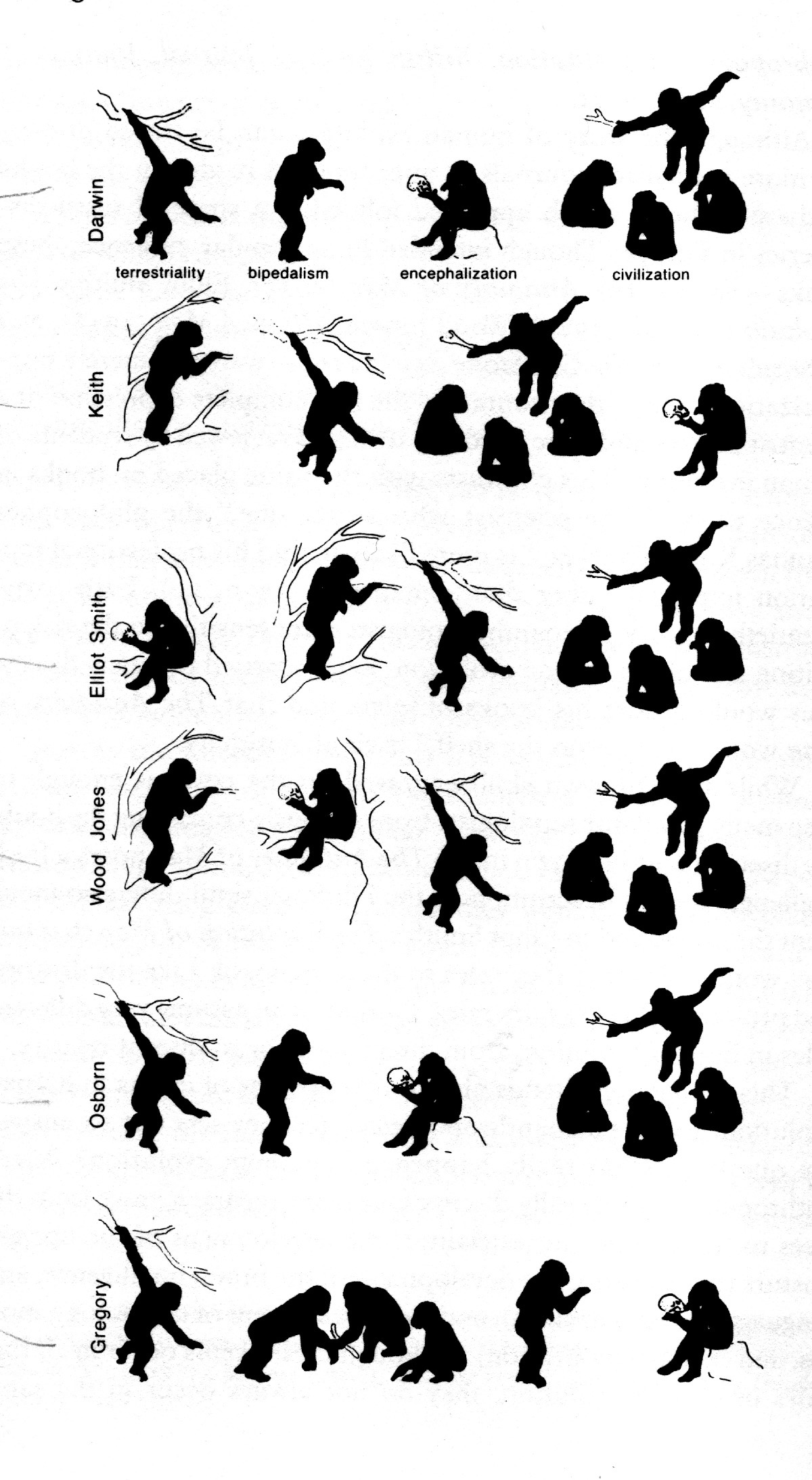
Orienting ourselves in terms of Biological and Early Cultural Trends: locomotion, brain, teeth, and tools
Although there are occasionally some very interesting and extremely surprising new finds, the general contours of human evolution are now well-drawn.
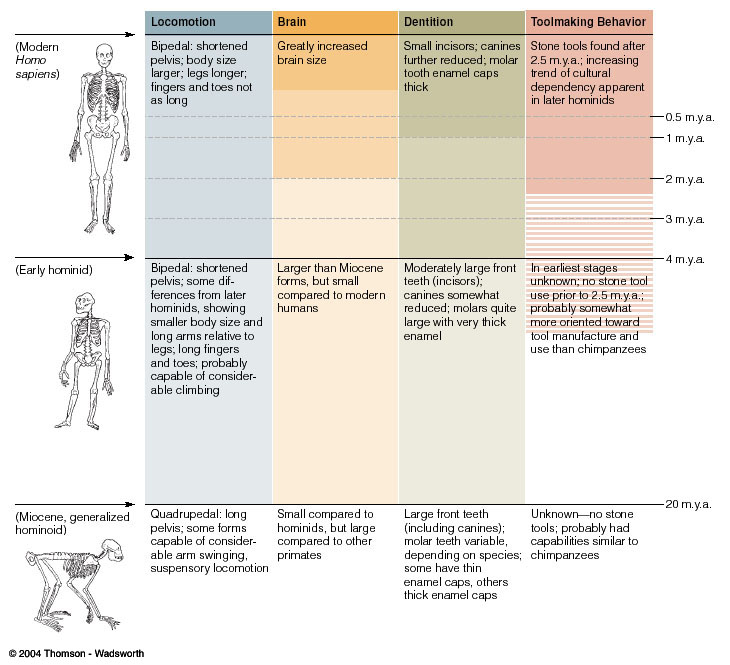
Bipedalism, expansion of brain (cranial capacity), modification of female pelvis, reduction of teeth, face, and jaws, extended period of infant and child dependence, apparent increased reliance on meat, emergence of tool use etc.
Bipedalism - changes in knee, foot (esp big toe), pelvis, spine curvature
Early hominids in general had 3 major adaptive problems - being large mammals, terrestrial primates, living in an open, savanna environment
Bipedalism might have been an advantage because increased ability to see predators and prey, free hands for carrying food and infants, tool use, long distance traveling more efficient.
Cranial capacity: Australos - 380 to 550 cc, vs. early Homo 630-640, vs. Homo sapiens sapiens (us!), usually 1300+ cc N.B. this does vary with body size, and the simple size of the brain alone does not mean greater intelligence within a species. Bigger and more complex brains - linked to stone tool making? around 2.5 mya (Oldowan tool industry),
Pre-australo species
Sahelanthropus tchadensis – Toro-Menalla region of Djurab Desert in Chad, Central Africa, 6-7 mya
Australo Species: new ones being discovered all the time! Most hominid fossils found in Great Rift Valley of East Africa, and also in South Africa. (Ethiopian, Tanzania, Kenya, and S. Africa)
More recent finds: A. anamensis, A. garhi, etc.
Gracile: A. africanus (Taung child) was an early discovery, A. afarensis (Lucy) was a big find in the 70s (40% of skeleton!), clearly bipedal
Australopithecus africanus – 3 to 2.5 mya, found by Raymond Dart in 1925 at Taung, South Africa
Australopithecus afarensis – about 3.2 mya, Maurice Taieb and Donald Johanson, Hadar, Ethiopia [well, actually, a student named Tom Gray], nicknamed “Dinkanesh” or “Lucy”
Laetoli footprints - 3.5 mya, australo, by Mary Leakey
Robust australos: (Paranthropus/A. boisei, robustus, aethiopicus)
Special note: the debates over species names and relative positioning are heated. Esp. Johanson and Leakey camps.
Homo species: bigger brains, reduced molars and premolars
2.5 mya onwards: Homo habilis (Olduvai)
Earliest tools seem 2.5 mya but dispute over who made them (A? H?) -- Oldowan tradition, chopper tools and flakes, pretty basic but very useful for cutting plants and also meat (n.b. we only have stone tools -- and what else might they have used?)
1.7 to 1.5 mya: Homo erectus emerges - significant because these are the first found out of Africa, in Europe and Asia (some have reclassified the African ones as H. ergaster). Early-discovered specimens: 'Java Man', 'Peking Man'. Bigger brain (895-1040 cc), different brain proportions, and larger overall body size (like us). Prominent, projecting brows. Very dense thigh bones. Developed Acheulean tool tradition from 1.5 mya. Clear evidence of big game consumption (hunting? scavenging?) Potential use of fire 1.4 mya, definite use and control of fire for cooking 500 000 BP in China. Also apparent use of basic structures. Language? Could be. Looks like their brains were up to it, at a basic level.
Archaic Homo sapiens
Considerable continuity between H. erectus and archaic H. sapiens in some place....hard to draw the line. (still, decreasing jaw, face, back teeth, cranial capacity)
Special notes about interpreting the fossil and archaeological record
We have to be careful about over-interpreting.... we need to be very aware of the limitations of our data.
e.g. we know that early hominids made stone tools. But there may have also been wooden tools that didn't survive.
e.g. we know that some early hominids ate meat, because we've found animal skeletons that clearly have butchering marks on the bones, from stone tools. BUT we don't know for sure whether they killed or scavenged. And we don't know directly what else they ate, because, for example, fruits don't leave behind skeletons. We can make inferences based on tooth wear, however. We can also make inferences based on the technology (e.g. you can't use an Acheulian handaxe as a throwing spear... )
e.g. when trying to understand social behaviour... we must be careful not to simply project present or recent human behaviour back into the past, or to use primate examples very literally. For example, if you want to make guesses about the social structure of Australopithecus afarensis:
- they're dimorphic in terms of overall size - which suggests that their social structure would be like gorillas (one dominant male, multiple females)
- but! their canines are not dimorphic, which suggests a social structure like gibbons (monogamous)
So we don't, and presently can't, know their mating patterns and social patterns.
We are presently alone... the last surviving hominid.... but this has not always been the case.
Gigantopithecus (well, a hominoid like other apes, but still a neat case)
http://www.eurekalert.org/pub_releases/2005-11/mu-gal111005.php
Neandertals
Homo floresiensis.
Homo floresiensis:
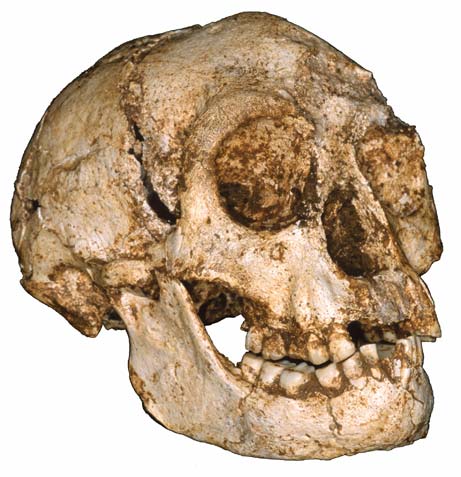
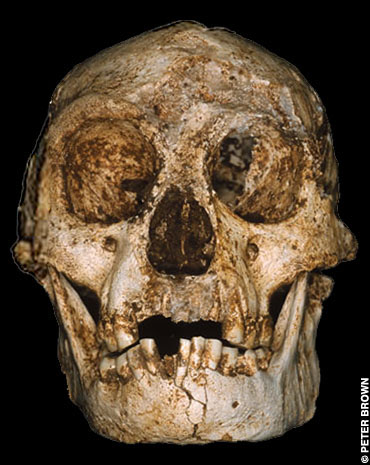
Remains of seven individuals found -- some very fragmentary. Best specimen is above and left: 3 feet/ 1m tall, female, around 30 years old, 18 000 BP. Brain: the size of a chimp's.
Found in eastern Indonesia on the island of Flores, at a cave site called Liang Bua
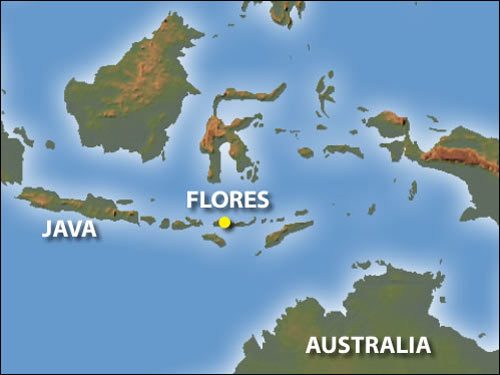
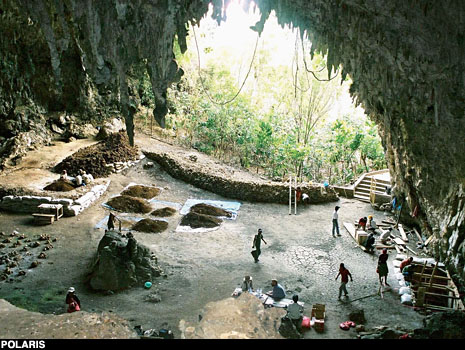
Size compared to modern H. sapiens - absolutely tiny
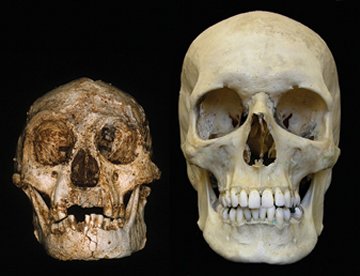

So what is it???
First, what it's not:
It's not "Mini-Me" or a dwarfed Homo sapiens or a known "pygmy". If it was simply a very small H.s., it would have all the same skeletal features ... and it doesn't. It's much smaller than the smallest known normal H.s. And it's not pathological: the actor below has achondroplasia - premature fusion of long bones, restricting height.... which would be clearly visible skeletally.
And it's not a Hobbit.


H. floresiensis... on the right, compared to H.s.s. and to H. erectus
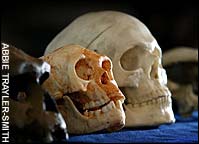

H. erectus comparisons
Below: Nariokotome boy, Turkana, Africa, H. erectus ... 1.5 mya. Right: "Peking Man", China, H. erectus, 500 000 bp
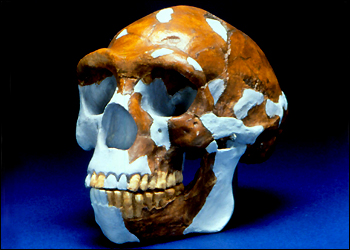
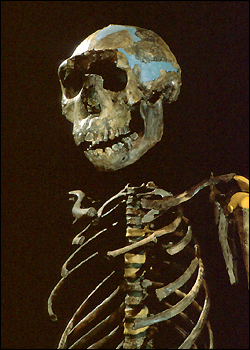
Creatures Homo floresiensis shared their world with:
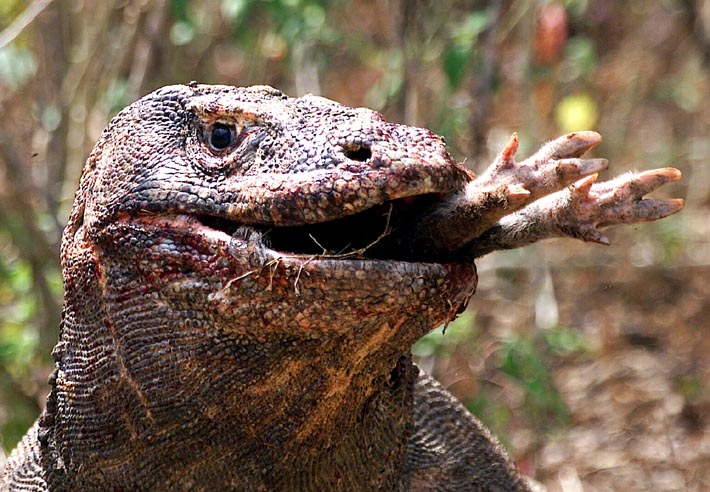
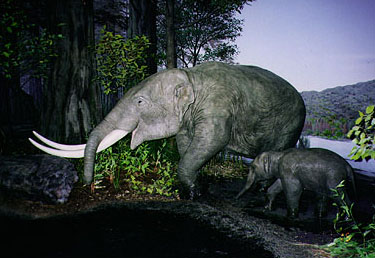
Komodo Dragons, pygmy Stegodon (elephant, not dinosaur Stegadon), and the Flores Giant Rat http://www.press.jhu.edu/books/walkers_mammals_of_the_world/rodentia/rodentia.muridae.papagomys.html
Major implications
a) Extreme physical adaptation in Homo
Island Dwarfism: e.g. Pygmy Mammoth http://www.nps.gov/chis/pygmy.htm
b) Completely surprising very late survival of H. erectus descendants... coexistence with Homo sapiens sapiens.... so not only did we coexist with Neandertals, but also with H. erectus descendants.... profound biologically and philosophically!
"For most of its 160 000 year history, H. sapiens seems to have shared the planet with other bipedal and cultural beings -- our global dominance may be far more recent than we thought." (M. Lahr and R. Foley, Human evolution writ small, Nature 27 Oct 2004 online http://www.nature.com/news/2004/041025/full/4311043a.html)
c) Revision of the family tree...
d) Further research: Search of other islands for similar specimens... and a reconsideration of ethnographic evidence/folklore...
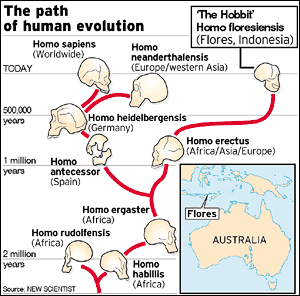
So..... a revision to the chart on p. 219 is warranted!
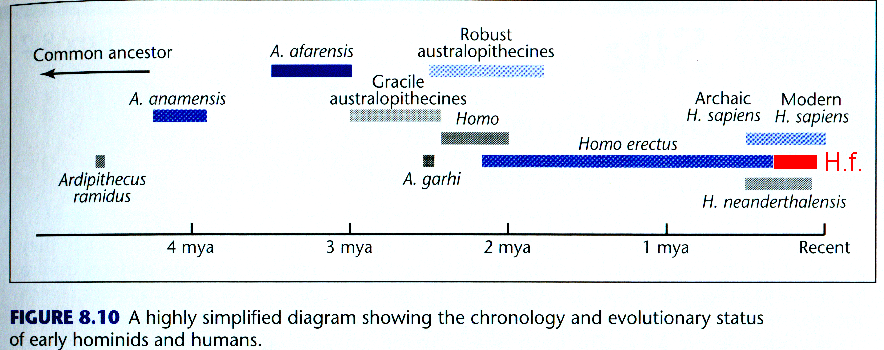
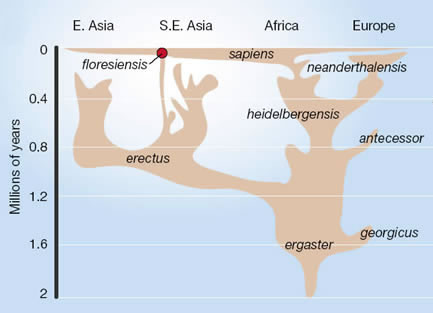
Above, From Nature: Figure 1. Homo floresiensis in the context of the evolution and dispersal of the genus Homo. The new species as part of the Asian dispersals of the descendants of H. ergaster and H. erectus, with an outline of the descent of other Homo species provided for context.
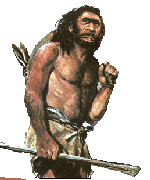
The Neanderthals... and their Disappearance
: (
Three things going on at once... or four!
Early Archaic Homo sapiens -- which gave rise to both us and and the Neanderthals - more developed than H. erectus, but clearly transitional - 600 000 to 130 000? dates vary. Widespread throughout Africa, Asia, Europe
Neandertals - a form of late Archaic H. s. - 130 000 to 35 000 BP, only in Europe and Middle East
Anatomically modern Homo sapiens sapiens – which is what we are – emerged in the Pleistocene epoch, maybe as early as 200 000, but definitely by around 120 000 bp.
n.b. it looks now as though we have very late H. erectus survivals too (H. floresiensis)
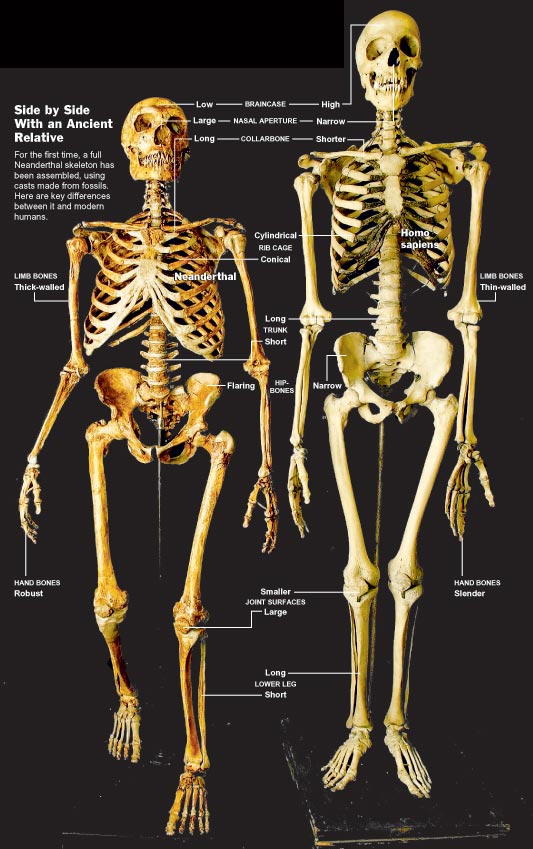
(Anatomically modern H.s.s. is defined by cranial architecture, lack of skeletal robusticity)
Images of Skulls only:
http://www.mnh.si.edu/anthro/humanorigins/ha/nead_sap_comp.html
Quicktime: http://www.pbs.org/wgbh/nova/neanderthals/skulls.html
(Consider: Why did species branch out when they did?)
So what do we actually know about the Neanderthal people?
Examples of Actual Neanderthal Skeletal remains
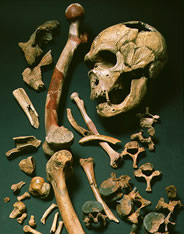 Neandertal: Original find,
1856, was amazingly controversial and very influential in later perceptions of
the Neandertal people. (First reconstruction based upon La Chapelle, an older
male suffering from severe arthritis.) Walked completely upright, looked much
like modern humans, actually had bigger brains than us, had sloping foreheads,
large brow ridges, large jaws, minimal chins. Lived throughout Europe, SW Asia,
and Central Asia.
Neandertal: Original find,
1856, was amazingly controversial and very influential in later perceptions of
the Neandertal people. (First reconstruction based upon La Chapelle, an older
male suffering from severe arthritis.) Walked completely upright, looked much
like modern humans, actually had bigger brains than us, had sloping foreheads,
large brow ridges, large jaws, minimal chins. Lived throughout Europe, SW Asia,
and Central Asia.
La Chapelle au Saints
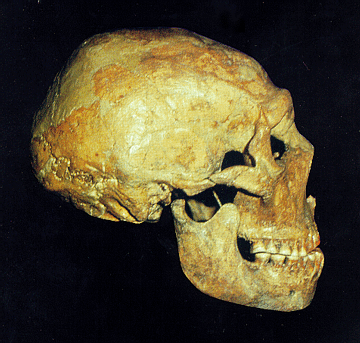
Shanidar.
Several specimens: http://www.mnh.si.edu/anthro/humanorigins/ha/neand.htm
More specimens: http://www.msu.edu/~heslipst/contents/ANP440/neanderthalensis.htm
We know
- their morphology and its changes over time
- some aspects of their behaviour
- some of their material culture
- some of their dwelling sites
The current state of debate about the Neandertals
Our Relationship To Them
- war? mating/merging? resource competition?
DNA- suggests we didn't interbreed
Morphology - potential hybrid skeleton suggests we interbred (if so, how common was this? were the hybrids fertile? did the genes end up represented in later populations, or were they swamped?)
Capabilities
- did they have our intellectual capacity for innovation and adaptation? (some say yes, some say no) (Mousterian tools are fairly conservative in design, not changing much)
- new research indicates that there is not only evidence for ritual behaviour (burials), but also art... which is a surprise to some
- what about language? there is no doubt that they communicated, but what about?
- sociality - survival of the injured indicates care and compassion... or does it?
And what, historically and in popular culture, have we thought about the Neanderthal?
 Neandertal: Original find,
1856, was amazingly controversial and very influential in later perceptions of
the Neandertal people. (First reconstruction based upon La Chapelle, an older
male suffering from severe arthritis.)
Neandertal: Original find,
1856, was amazingly controversial and very influential in later perceptions of
the Neandertal people. (First reconstruction based upon La Chapelle, an older
male suffering from severe arthritis.)
La Chapelle au Saints
Archaeology scholars S. Moser and M. Wiber have examined reconstruction illustrations and have noticed several key themes.
- there are 'icons' which tend to be present in these images, signifying primitivity and a separation from us: spears, clubs, skulls, long hair, etc.
- the relative positioning and activities of males, females, and children say a lot about perceived gender relationships in the past -- and in the present. (males tend to be the very 'Man the Hunter', are the ones with tools, weapons, are looking the most inventive, and are located centrally in the image)
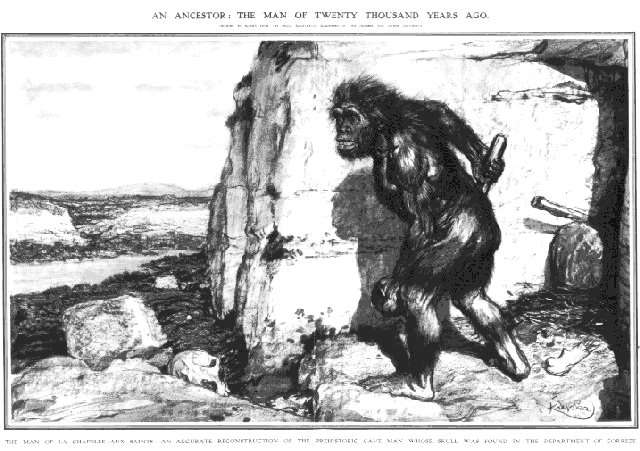
Above: by Kupka, based on Boule, 1909
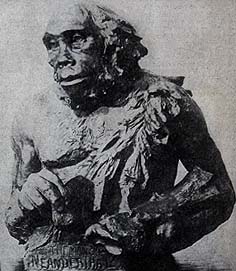
1928 reconstruction of Neanderthal
"Dissing the Neanderthal" in Chicago: http://129.237.227.3/explore/v1n2/neander1.html
Neanderthals as savage: http://www.talkorigins.org/faqs/homs/savage.html
Another great collage: http://www.mun.ca/biology/scarr/Neandertal_drawings.jpg
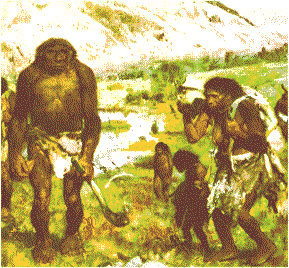
Zdenek Burian painting of Neanderthals. (mid 1900s)
Put a hat on a Neanderthal...

"The traditional earlier view of the Neanderthals as stooping 'ape-men' (which they were certainly not) was based largely on superstition and on the discovery of a few individuals with advanced bone disease at death. Carleton Coon's 1939 portrait of the Chapelle-aux-Saints Neanderthal type individual in modern dress makes the point that artists' impressions depend very much on superficial things like dress and haircut." - http://www.orc.soton.ac.uk/view/402/
Channel 4, UK, recent series on Neanderthals
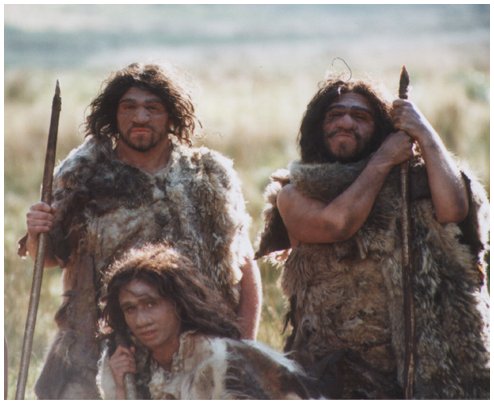
2001. Neanderthal child, computerized reconstruction.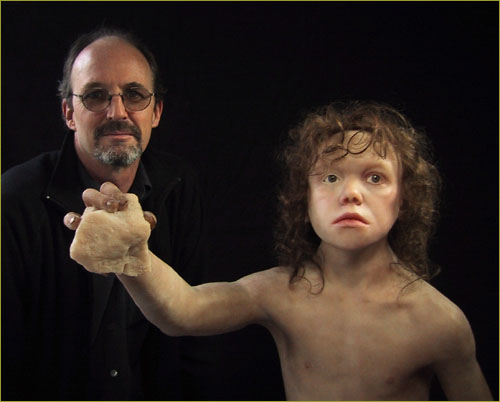
http://www.pbs.org/wgbh/nova/neanderthals/prod_03.html
So consider, for tomorrow's tutorial...
Why the public fascination with the Neandertals?
And what should we be looking for in representations of early people... if we want to analyze those representations anthropologically?
Further information on Neandertals
There are many great books available on the Neandertals.
Also:
Summary: http://anthro.palomar.edu/homo2/neandertal.htm
Examine skulls and skeletons of H.s.n. and H.s.s.: http://www.pbs.org/wgbh/nova/neanderthals/skulls.html, http://www.mnh.si.edu/anthro/humanorigins/ha/neand.htm, http://www.channel4.com/history/microsites/N/neanderthal/facts/looked_like.html, http://www.newscientist.com/news/news.jsp?id=ns99993555, http://www.bbc.co.uk/science/cavemen/chronology/contentpage5.shtml
Conflict and care: http://www.sciam.com/article.cfm?articleID=00037FE6-1048-1CD0-B4A8809EC588EEDF
An argument (and there are others against this view) for replacement: http://news.nationalgeographic.com/news/2003/03/0306_030306_neanderthal.html
A history of Neandertal... stamps!? http://www.franadams.com/exhibits/neandtal/neanxhbt.html
Hint: when looking for stuff on H.s.n., always search with "Neanderthal" and "Neandertal". The spellings are both correct, and are used somewhat interchangeably.
--------------
From Nature: Published online: 10 September 2002
Palaeontologists strike gold in nineteenth-century rubbish.
|
You wait the best part
of a century for a lost Neanderthal skeleton to be rediscovered, and then two
come along in a week.
Palaeontologists working in the German valley
that gave Neanderthals their name have found the remains of human skeletons,
their tools and the animals that lived alongside them1.
The bones were dug up for the first time, and subsequently discarded, nearly 150
years ago. The finding follows the Neanderthal baby recently found in a French
museum 90 years after its excavation2.
In 1856, quarry workers unearthed the first ever
Neanderthal bones in a cave on the side of the Neander valley, near Düsseldorf.
The larger bones were kept, but the rest of the cave's contents were thrown into
the valley floor 20 metres below.
By the time the bones were recognized as early
human, several weeks later, the cave had been quarried away and the other
fragments buried.
Palaeontologist Fred Smith of the Loyola
University of Chicago and his colleagues used historical records to work out
where the cave's contents might have fallen.
After picking their spot, and digging down for
four metres, they struck bone. One of the first fragments unearthed fitted onto
the thigh bone of the original Neanderthal. "It's little short of miraculous,"
says Smith.
The team now has about 75 fragments. They have
found pieces of the first skeleton's skull, plus remains from at least two
previously unknown individuals.
Carbon dating reveals that the newly found
Neanderthals lived during the Ice Age, about 40,000 years ago - around the same
time as the first skeleton. Neanderthals are thought to have arrived in Europe
about 120,000 years ago, and died out 90,000 years later.
But DNA from the new specimens hints that they
might be more closely related to Neanderthals from eastern Europe than to their
German neighbour. Too few skeletons have been analysed to be sure, says Smith,
but it is possible that Neanderthals travelled long distances.
In context
Smith's team also found stone tools, and bones
of other animals from the same period. These are the most exciting aspect of the
discovery, says archaeologist Clive Gamble of the University of Southampton, UK.
The first Neanderthal "had always been a
floating fossil - it lacked a context", says Gamble. The new evidence grounds
him in the bigger picture of what we now know about Neanderthals.
|
|
|||
|
|
||||
If the tools had been
found in 1856, Neanderthal man might have got a friendlier reception. Many
people refused to believe that the bones were old - this was before Darwin's
Origin of Species was published, after all. Some thought that the skeleton
belonged to a Russian soldier killed in the Napoleonic wars.
"Those arguments would have been invalid before
they'd been made," says Smith. "The early history of human palaeontology might
have been very different."
|
|
|
|
|
|
|
|
|
|
|
|
References
|
|
|
|
Further information on Homo Floresiensis
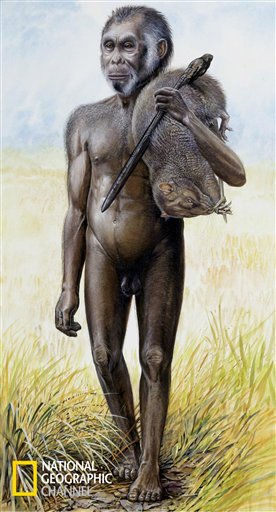
Nature
Published online:
27 October 2004; | doi:10.1038/4311043a
We are the only living species of the genus Homo. Given the startling results of a cave excavation in Southeast Asia, it seems that we coexisted with another species until much more recently than had been thought.
We are the only living species of the genus
Homo.
Given the startling results of a cave excavation in Southeast Asia, it seems
that we coexisted with another species until much more recently than had been
thought.
The fossils
described elsewhere in this issue probably left no descendants, are not very
old, and were found on a remote island. Despite this, they are among the most
outstanding discoveries in palaeoanthropology for half a century. The two papers
concerned - by Brown et al.1
and Morwood et al.2
- respectively describe the fossils and their archaeological context.
The find is
startling. It is of a pygmy-sized, small-brained hominin, which lived as
recently as 18,000 years ago, and which was found on the island of Flores
together with stone tools, dwarf elephants and Komodo dragons. Discoveries don't
get better than that.
The Flores
fossils add a new and surprising twig to the hominin family tree, which diverged
from the chimpanzee lineage about 7 million years ago (See
Figure 1). The first African hominins existed 7-1.2 million years
ago, were 1-1.5 metres tall, walked upright on two legs (that is, were bipedal),
and had chimpanzee-size brains.
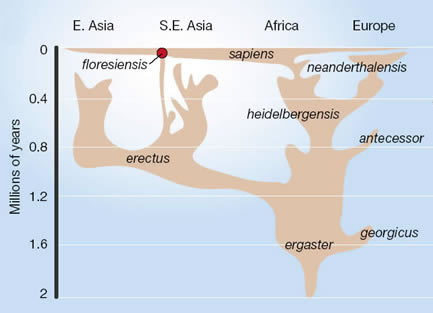
Figure 1. Homo
floresiensis in the context of the evolution and dispersal of the genus
Homo.
The new species as
part of the Asian dispersals of the descendants of H. ergaster and
H. erectus, with an outline of the descent of other Homo species
provided for context.
These early forms comprised as many as six genera and fourteen species, of which
the australopithecines are the best known. By 2.5 million years ago, our own
genus, Homo,
had emerged, with its different body shape, slower growth, greater reliance on
meat in the diet, and 'encephalization' - larger brains than expected for body
size.
These were the
first hominins to make stone tools systematically and to colonize Eurasia. They
include the familiar names of H.
habilis,
H. erectus,
H. neanderthalensis
and, finally, H. sapiens,
which put in an appearance about 160,000 years ago. The new fossil is part of
this Homo
group.
Flores lies to
the east of Java, and was probably never connected to the mainland. The presence
of 800,000-year-old simple stone tools first attracted attention in 19983,
raising the controversial possibility that
H. erectus
had produced them and had crossed major sea barriers to reach Flores.
Now we have the
announcement of the discovery of an 18,000-year-old hominin skeleton from a
cave, Liang Bua, on Flores. Although this date is more than 140,000 years after
modern humans evolved in Africa, more than 25,000 years after
H. sapiens
reached Australia, and about 10,000 years after the last known Neanderthal, the
skeleton is that of a new species -
Homo floresiensis.
Its most
remarkable features are its diminutive body (about a metre in height) and brain
size (at 380 cm3, the smallest of any known hominin).
Homo
floresiensis is a challenge - it is the most extreme hominin ever discovered. An
archaic hominin at that date changes our understanding of late human
evolutionary geography, biology and culture. Likewise, a pygmy and small-brained
member of the genus Homo
questions our understanding of morphological variability and allometry - the
relation between the size of an organism and the size of any of its parts.
Brown et al.1
claim that the skeleton, designated LB1, represents a new species within the
genus Homo.
They believe that it may have been a female. They also conclude that it was a
dwarfed descendant of Javanese H.
erectus, and part of an endemic island
fauna. But what other taxonomic assignments are possible?
Convergence - a
process through which two species become more similar to each other than their
ancestors were - is a strong evolutionary force4,
and LB1, with its minute brain, could be a convergent Southeast Asian ape.
But it
evidently was an obligatory biped and had small canine teeth, key hominin traits
that, with the rest of its morphology, firmly place it within the hominin group5.
Given its body and brain size, as well as some other features, could the remains
be those of an australopithecine?
Those features
include bony reinforcements along the sides of the nose, thigh bones that were
less obliquely aligned than ours (a trait essential for the way we walk and deal
with gravity), and pelvic bones that were very wide, giving it a different
overall body shape from ours. But the answer is again no. Most of LB1's other
characteristics, such as the thickness and proportions of the skull, the flexion
evident at the skull base, and the shape of the teeth, are derived traits of the
genus Homo.
Could LB1 be a
pygmy H. sapiens?
Again, no. Compared with a human skull scaled to less than a third of full size,
the LB1 skull differs in shape, robusticity and key features of the base.
Furthermore, although human pygmies are short (1.4-1.5 m), they show very little
reduction in brain size, probably because their small size is attained through
mechanisms that curtail growth during puberty, when brains are already fully
grown6.
In general
terms, LB1's morphology groups it with
H. erectus7.
The name includes African and non-African hominins with brains smaller than
1,250 cm3, which may be one species (H.
erectus), or several (antecessor,
cepranensis,
erectus,
ergaster,
georgicus,
mauritanicus
and soloensis).
Height among
these 'erectines' is considered8
to range between 1.55 m and 1.78 m, and brain size between 650 cm3
and 1,260 cm3. The body and brain size of LB1 (about 1 m and 380 cm3)
clearly indicate a major departure from the erectine extremes, while its
peculiar combination of primitive and derived traits points towards the complex
effects of dwarfism and its allometric consequences (See
Figure 2).
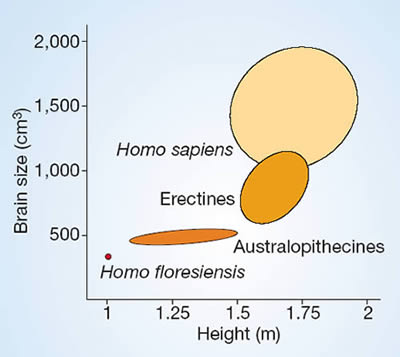
Figure 2. The relative brain and body size of H. floresiensis
The dimensions of the skull and skeleton (LB1) described by Brown et al. fall well outside the extremes seen in H. sapiens and the 'erectines' (a range of hominin species, of which H. erectus is the most familiar). LB1 is closer in size to, but even smaller than, the australopithecines, of which the best known example is Lucy. On various anatomical grounds, however, Brown et al. believe that LB1 represents a dwarfed H. erectus.
Island dwarfism is well known among mammals9.
Released from predation pressure or constrained by restricted resources, and
limited by population size, the phenomenon can be dramatic. Some examples can be
truly extreme - for example, the one-metre-high fossil elephants, found on
Sicily and Malta, which may have become dwarfed from a 4-metre ancestor in less
than 5,000 years10.
Indeed, remains of now-extinct primitive elephants (Stegodon), which had become
dwarfed in relation to their mainland relatives, were found in the same deposits
as LB1.
The dwarfism of
Homo floresiensis
is also dramatic, resulting in the shortest adult
Homo,
and possibly hominin, known. Most significantly, the relative proportions of
LB1's brain and body size indicate that the size reduction was more pronounced
in the brain than the body, so a non-encephalized descendant evidently arose
from an encephalized ancestor. This raises many questions about encephalization
and hominin behaviour.
Such questions
aside, Homo floresiensis is clear evidence that, in spite of their 'cultural niche', hominins
were subject to the same evolutionary rules as other widespread mammals, with
local isolation and small population sizes producing differentiation in size and
form. This find strengthens the view that the genus
Homo
was probably much subdivided, resulting in a bushy human evolutionary tree. That
view is itself consistent with the idea that the extreme climatic shifts of the
past million years promoted population dispersal and isolation, and potentially
resulted in instances of local evolution11.
Necessarily,
the discovery of Homo floresiensis bears on the
debate over the origins of modern humans - whether
H. sapiens evolved in various
regions throughout the world from H.
erectus populations, or as a distinct
and recent African species. Multiregional evolution requires the existence of
large populations for long periods, with isolation being rare or absent so that
the global species could evolve in a single direction.
Palaeoanthropological and genetic studies have already done much to discredit
this model, and Homo floresiensis
puts yet another (the last?) nail in the multiregional coffin. Not only did
Homo floresiensis
evolve in the absence of gene exchange with other hominins, but no one can argue
that LB1 contributed to our own species' genetic make-up.
Finally,
accomplishing the sea-crossing that must have been necessary for the founding
population to reach Flores adds to the baffling evidence for complex, supposedly
'sapient', behaviours among archaic hominins12. And the behaviour of
H. floresiensis
itself, of course, remains elusive. Are the 800,000-year-old stones really
artefacts? If so, does their date indicate when the taller ancestors of the
dwarfed form arrived?
The
archaeological evidence is controversial. The 800,000-year-old artefacts are
simple, crudely flaked pebbles, similar to those found with Javanese
H. erectus,
as are some found at Liang Bua dating to more than 100,000 years ago.
Only a few
tools are associated with LB1. But thousands were found with the Stegodon
skeleton in another sector of the cave: some are small flakes struck from radial
cores; others consist of points, perforators, blades and possibly hafted
microblades. Although Morwood et al.2
attribute the production of all of these tools to
H. floresiensis, elsewhere such implements are associated with
H. sapiens,
and their contrast with tools found anywhere with
H. erectus
is very striking.
One could
speculate that modern humans, who were dispersing across southern Asia between
100,000 and 50,000 years ago, may have made the tools, and come across these
creatures. They may also have had a part in their ultimate extinction.
It is
breathtaking to think that such a different species of hominin existed so
recently. Brown et al.1 point to the probability of similarly unexpected fossils
being found in other isolated areas. For most of its 160,000-year history,
H. sapiens
seems to have shared the planet with other bipedal and cultural beings - our
global dominance may be far more recent than we thought.
Marta Mirazón
Lahr and Robert Foley are in the Leverhulme Centre for Human Evolutionary
Studies, Department of Biological Anthropology, University of Cambridge, UK.
|
References
|
Some free articles here at News@nature.com: www.nature.com/news/specials/flores/index.html
Peter Brown and Mike Morwood. The Flores find
Rex Dalton. Little lady of Flores forces rethink of human evolution
Chris Stringer. A stranger from Flores
Henry Gee. Flores, God and cryptozoology
Also see the Interactive Graphic and, at the very bottom of that page, the abstracts for the research papers.
Optional others:
Marta Lahr and Rob Foley. Human evolution writ small. from Nature. Pasted at the bottom of this webpage.
Christopher Joyce, NPR. Ancient, Tiny Humans Shed New Light on Evolution (interview with finders). http://www.npr.org/templates/story/story.php?storyId=4127713
Wong, Kate. Digging Deeper: Q&A with Peter Brown. http://www.sciam.com/print_version.cfm?articleID=00082F87-7D35-117E-BD3583414B7F0000
Keys, David. 2004. Indonesia's Lost World: Shaking Up the Family Tree. Archaeology online. http://www.archaeology.org/online/features/flores/
Desmond Morris. Eton or the Zoo? http://news.bbc.co.uk/1/hi/magazine/3964579.stm
David Wilkinson. What does it mean to be human? http://news.bbc.co.uk/2/hi/uk_news/magazine/3971045.stm
Henry Gee. Our Not So Distant Relative. http://www.guardian.co.uk/print/0,3858,5048775-111414,00.html
'Hobbit' joins human family tree. BBC. http://news.bbc.co.uk/1/hi/sci/tech/3948165.stm
"Hobbit" Discovered: Tiny Human Ancestor Found in Asia. http://news.nationalgeographic.com/news/2004/10/1027_041027_homo_floresiensis.html (see also the photo gallery there)
Go to Google News http://news.google.ca/nwshp?hl=en&gl=ca and type in Hobbit, or Homo floresiensis, or Ebu Gogo, and see what comes up. Explore -- remembering that not all coverage is reliable.